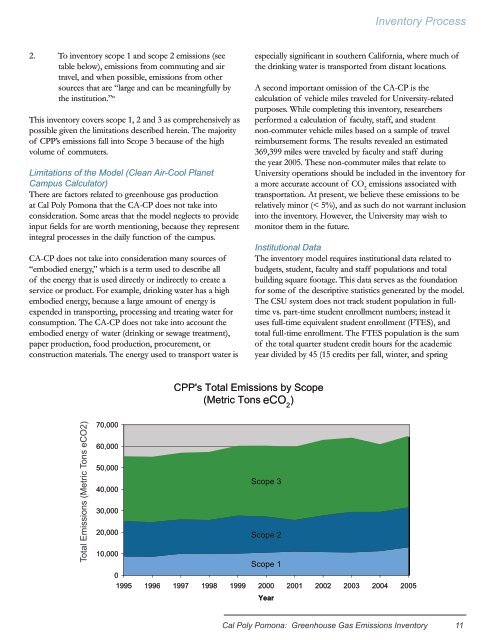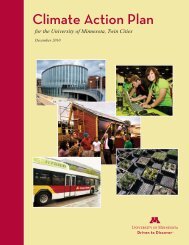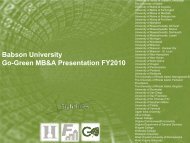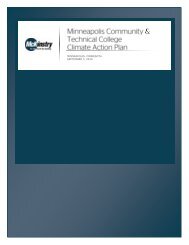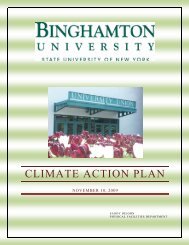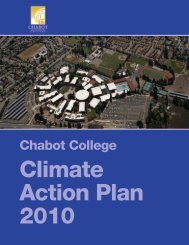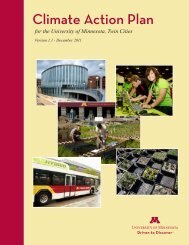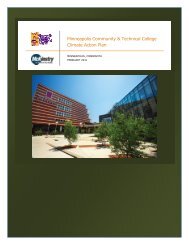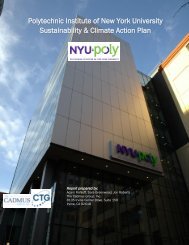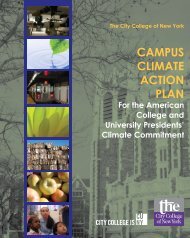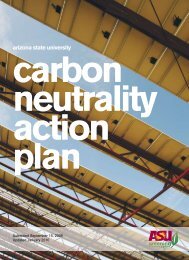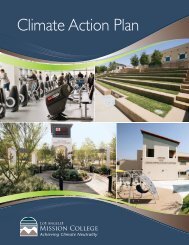Greenhouse Gas Emissions Inventory Report - Cal Poly Pomona
Greenhouse Gas Emissions Inventory Report - Cal Poly Pomona
Greenhouse Gas Emissions Inventory Report - Cal Poly Pomona
You also want an ePaper? Increase the reach of your titles
YUMPU automatically turns print PDFs into web optimized ePapers that Google loves.
<strong>Inventory</strong> Process<br />
2. To inventory scope 1 and scope 2 emissions (see<br />
table below), emissions from commuting and air<br />
travel, and when possible, emissions from other<br />
sources that are “large and can be meaningfully by<br />
the institution.” n<br />
This inventory covers scope 1, 2 and 3 as comprehensively as<br />
possible given the limitations described herein. The majority<br />
of CPP’s emissions fall into Scope 3 because of the high<br />
volume of commuters.<br />
Limitations of the Model (Clean Air-Cool Planet<br />
Campus <strong>Cal</strong>culator)<br />
There are factors related to greenhouse gas production<br />
at <strong>Cal</strong> <strong>Poly</strong> <strong>Pomona</strong> that the CA-CP does not take into<br />
consideration. Some areas that the model neglects to provide<br />
input fields for are worth mentioning, because they represent<br />
integral processes in the daily function of the campus.<br />
CA-CP does not take into consideration many sources of<br />
“embodied energy,” which is a term used to describe all<br />
of the energy that is used directly or indirectly to create a<br />
service or product. For example, drinking water has a high<br />
embodied energy, because a large amount of energy is<br />
expended in transporting, processing and treating water for<br />
consumption. The CA-CP does not take into account the<br />
embodied energy of water (drinking or sewage treatment),<br />
paper production, food production, procurement, or<br />
construction materials. The energy used to transport water is<br />
especially significant in southern <strong>Cal</strong>ifornia, where much of<br />
the drinking water is transported from distant locations.<br />
A second important omission of the CA-CP is the<br />
calculation of vehicle miles traveled for University-related<br />
purposes. While completing this inventory, researchers<br />
performed a calculation of faculty, staff, and student<br />
non-commuter vehicle miles based on a sample of travel<br />
reimbursement forms. The results revealed an estimated<br />
369,399 miles were traveled by faculty and staff during<br />
the year 2005. These non-commuter miles that relate to<br />
University operations should be included in the inventory for<br />
a more accurate account of CO 2<br />
emissions associated with<br />
transportation. At present, we believe these emissions to be<br />
relatively minor (< 5%), and as such do not warrant inclusion<br />
into the inventory. However, the University may wish to<br />
monitor them in the future.<br />
Institutional Data<br />
The inventory model requires institutional data related to<br />
budgets, student, faculty and staff populations and total<br />
building square footage. This data serves as the foundation<br />
for some of the descriptive statistics generated by the model.<br />
The CSU system does not track student population in fulltime<br />
vs. part-time student enrollment numbers; instead it<br />
uses full-time equivalent student enrollment (FTES), and<br />
total full-time enrollment. The FTES population is the sum<br />
of the total quarter student credit hours for the academic<br />
year divided by 45 (15 credits per fall, winter, and spring<br />
CPP's Total <strong>Emissions</strong> by Scope<br />
(Metric Tons eCO2) 2<br />
Total <strong>Emissions</strong> (Metric Tons eCO2)<br />
70,000<br />
60,000<br />
50,000<br />
Scope 3<br />
40,000<br />
30,000<br />
20,000<br />
Scope 2<br />
10,000<br />
Scope 1<br />
0<br />
1995 1996 1997 1998 1999 2000 2001 2002 2003 2004 2005<br />
Year<br />
<strong>Cal</strong> <strong>Poly</strong> <strong>Pomona</strong>: <strong>Greenhouse</strong> <strong>Gas</strong> <strong>Emissions</strong> <strong>Inventory</strong> 11


